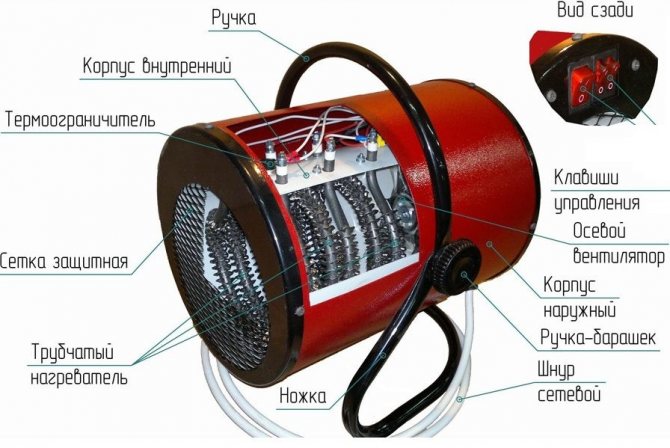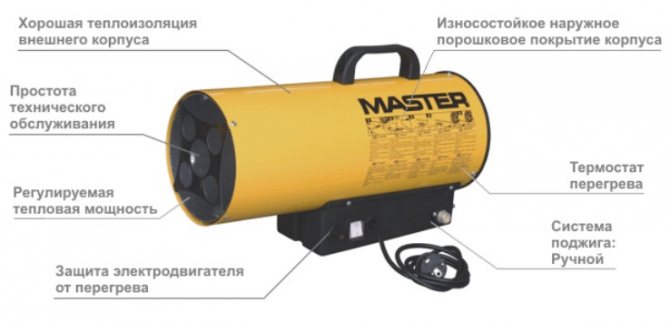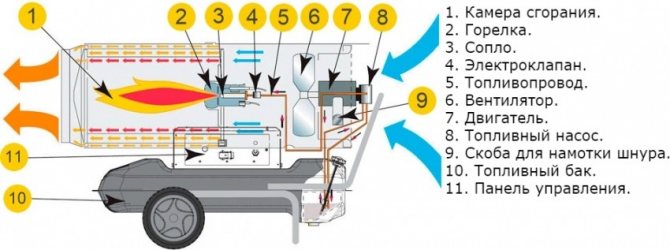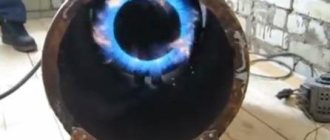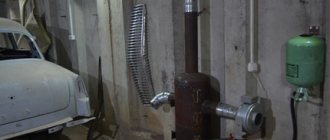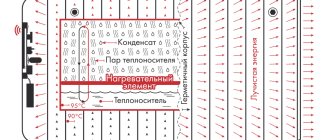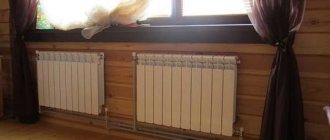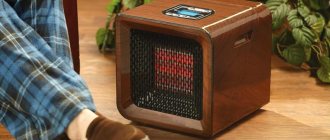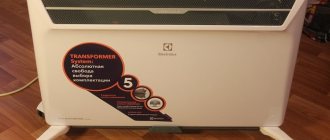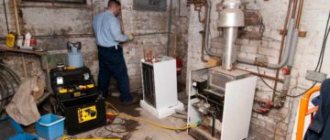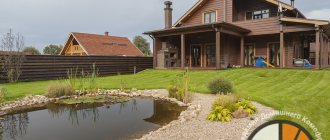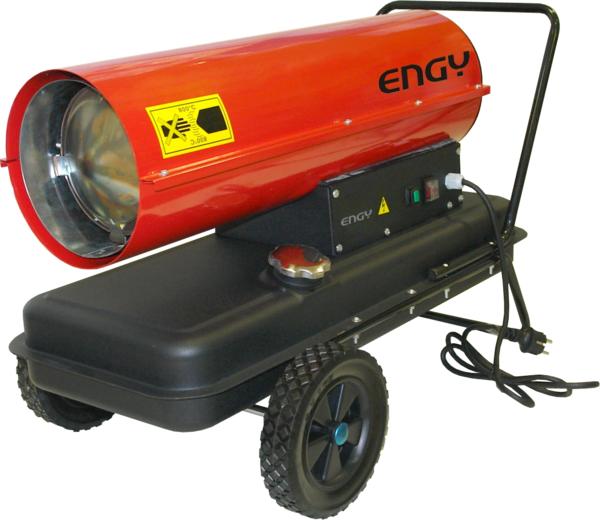
A popular and convenient air heater is the heat gun
Heat guns have a fairly wide range of applications: they are used to heat garages, warehouses, construction sites; installation of PVC ceilings, concrete screeds, etc. The devices gained such popularity due to their ability to quickly and economically heat a room. In addition, it is often not difficult to move the device: the weight of the gun, on average, is from 2 to 16 kg. What are heat guns and how to choose a highly efficient installation for various needs - read below.
Which heat gun is better: gas or diesel
Today, manufacturers produce thermal devices that can operate on diesel fuel, gas, and electricity. The most economical are diesel and gas heaters. Due to the widespread use of fuel, the gasoline heat gun is especially popular. The choice of a heating installation depends on the size of the room for which the device is selected and the quality of the ventilation system in the building.
So, diesel cannons are most often chosen for heating large industrial premises: they work quite noisily, and at the time of launch they emit an unpleasant odor.
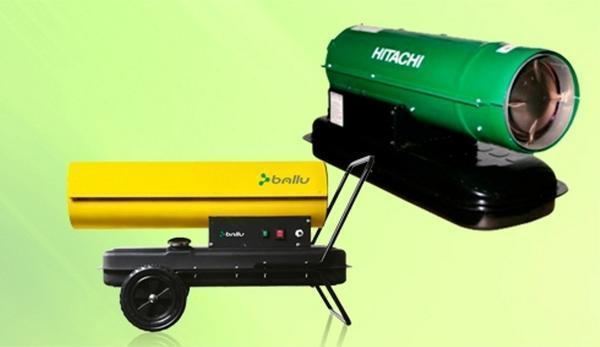

If you want to use a diesel device for mounting vinyl ceilings or drying concrete screed, then the repair room should be well ventilated and the gun should have a special chimney. However, diesel heaters are powerful and durable. And in case of breakdowns, it is much easier to repair diesel equipment than gas equipment.
The diesel cannon can also run on waste oil, which makes it even more economical to use.
Gas fired heat guns are handy devices that can be easily moved. They work quieter than diesel ones and are equipped with a gas cylinder, which solves the problem with refueling the device. In addition, the main advantage of gas cannons, in comparison with diesel ones, is that they do not generate an unpleasant odor during operation. However, the gas cannon “burns out” oxygen, so it is not recommended to use it in closed, small spaces.
When choosing a heater for a garage, you need to take into account the area of the room and the climate. How to make the right choice? Our tips on the next page:
The device and types of heating guns
The principle of operation of heat guns is similar to the operation of convectors, but they have a different shape - most often they are made in the form of a cylinder. This unit has a heat source and a fan behind it. The source of heat can be a heated coil, heating element (tubular electric heater), fuel burning in the burner. Energy resources are converted into heat, and a working fan actively "blows" this heat into the room. As a result, the room temperature rises quickly. Therefore, heat guns are used to heat rooms in an emergency mode.
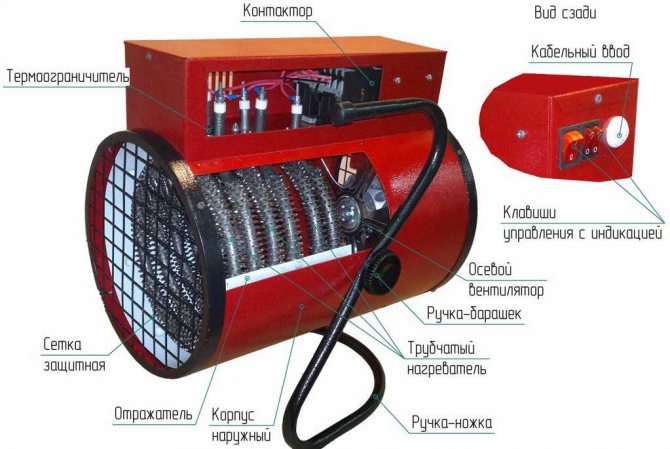

Electric heat gun device
More sophisticated models can have multiple fan speeds, a thermostat that allows you to control the temperature, and other bells and whistles. With them it is more convenient and often more economical. These heat guns can be used to heat living spaces. But they have little effect on the principle of operation. They work on different types of energy sources:
- Electricity: from 220 V (power up to 8-10 kW);
- from 380 V (power above 10 kW).
- on gas (natural and liquefied);
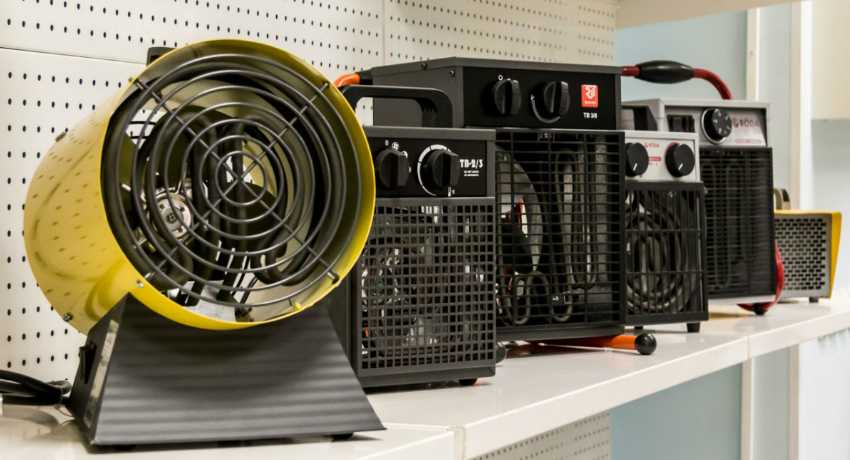

There are not only round, but also rectangular
Despite the fact that all equipment has the same name, there are serious differences, advantages and disadvantages. There are also nuances in terminology: electric heat guns are often called fan heaters, and when they talk about heat guns, they mean gas or fuel models. But this is far from always, since electric heat guns in the standard version in the form of a cylinder are not very similar to traditional fan heaters.
Electric models and how they differ from fan heaters and convectors
To begin with, let's consider what is the difference between heat guns and other heating electrical appliances. If you look at its structure, we can say that they are arranged in almost exactly the same way as fan heaters. And there, and there, there may be a spiral or heating element, there is a fan. So what's the difference?
Basically, the difference is in power and purpose. A fan heater is not a very powerful device designed for heating small and medium-sized premises. It is often used when the main heating system does not cope with its task - in cold weather or in the off-season. Fan heaters are designed for long-term operation, to maintain the required temperature. At the same time, the temperature rises smoothly, since the power of this type of heater is small.
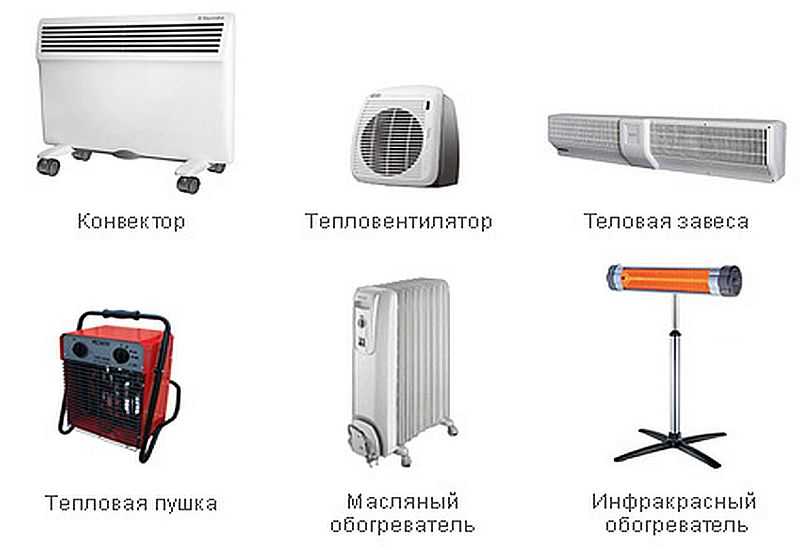

The difference between electric guns and fan heaters is in power
Heat guns are powerful devices (from 5 kW and above) and are able to warm up the air in a room or garage very quickly. But it is not very convenient to maintain the temperature with their help - the high power simply does not allow it to be done accurately and smoothly. In a limited room, even a short-term activation gives a sharp jump in temperature. In general, heat guns for heating residential premises are not very convenient. There are, of course, schemes for stepwise switching on of heating elements. But they are not often found in heat guns - the purpose is still different: for large industrial premises, where their power is just right. And, due to the large volumes of air, temperature jumps are far from so noticeable.
There is another similar device - electric convectors. Sometimes you have to choose between a heat gun and a convector. The situation is different with them. Classic convector models are designed so that the air moves in them by natural processes - without the fan running. So the difference between classic convectors and electric heat guns is in the presence of a fan.
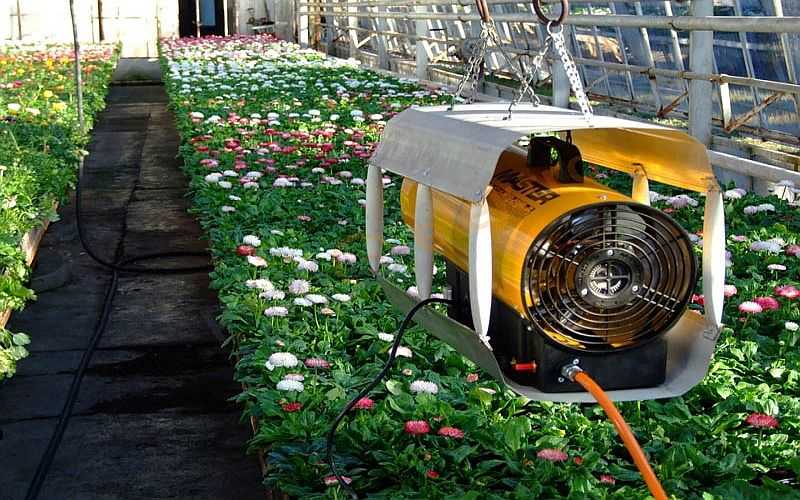

For heating greenhouses, heat guns are a good solution.
In addition, since fan heaters and convectors were developed as household appliances, they have a good design. The same cannot be said about heat guns. A piece of pipe is not very attractive in appearance. During the development, not too much attention was paid to the appearance, the emphasis was on performance. That's all the difference between heat guns and convectors or fan heaters.
Now about the advantages and disadvantages of electric heat guns. Electric heat guns make almost no noise, "do not smell" and these are their advantages. However, they are rarely used. And all because they consume a lot of electricity, which is not cheap. In addition, not all networks can withstand the required power. In order to warm up the room quickly, you need a power of 10 kW. The minimum is 8 kW, but with such a power, the heating time will take much more. In any case, such a load is not enough for any household network to pull.And certainly not a suburban power grid (although, for a small dacha, you can try models for 5 kW). Moreover, it must be borne in mind that many copies are connected to three-phase networks (380 V).
Gas models
Gas heat guns are equipped with burners that run on main or liquefied gas. Those designed for liquefied gas can be equipped with a hose and a reducer, so that for the first start, all that remains is to connect a liquefied gas cylinder. Just note that for operation, you need to be connected to a 220 V network: the device has an electric fan, controllers and automation, which require power. Electricity consumption is very small - even the most powerful units consume no more than 500 W per hour.
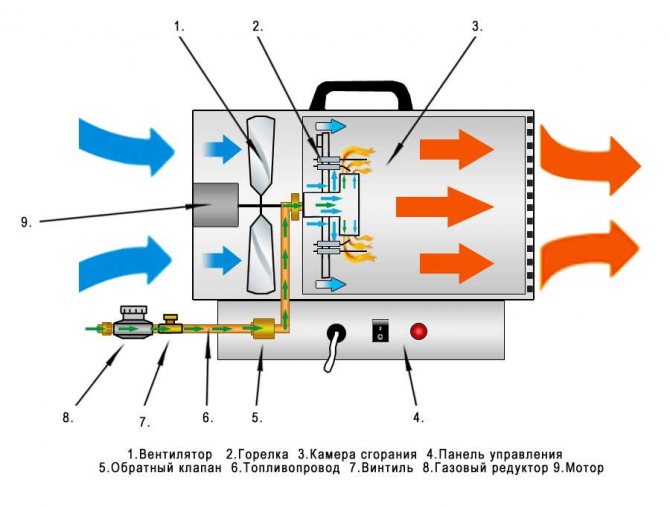

Gas heat gun device
The power of gas heat guns is from 5 to 580 kW. They can also be used for heating residential premises. The gas burns out almost completely, there is exhaust, but for low-power devices it is no more than from a gas stove, boiler or water heater. But oxygen is used for combustion, so good ventilation is necessary for normal well-being.
As with any gas equipment, gas heat guns for space heating carry a potential hazard. Therefore, most of the modern models are equipped with devices that guarantee safety. There is a flame presence sensor that will turn off the gas supply if the flame goes out. To save fuel and maintain a stable temperature, heat regulators are built into the devices. With their help, the temperature is set, which is automatically maintained by the control unit.
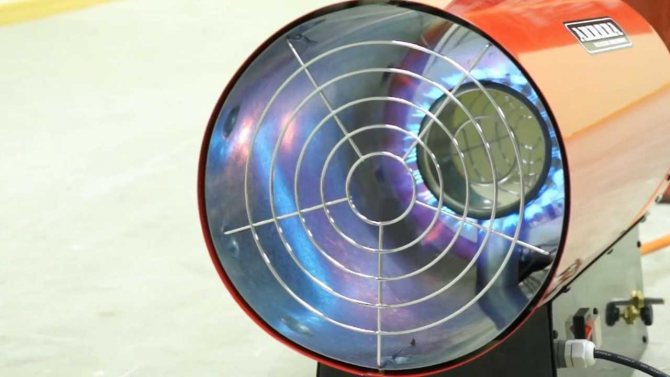

This is what a gas apparatus looks like during operation
If we talk about the features of operation, we must remember that gas in cylinders can freeze. In order to warm up in frosts, for example, a garage, it is necessary to bring the cylinder from a warm room.
Important! The gas cylinder is often heated locally. those. air flow from a working gun - from overheating it can explode. It is possible that the cylinder is overfilled and even its slight heating can lead to an explosion. Unfortunately, such cases are not uncommon. The cylinder must be filled to no more than 80% of its capacity.
Diesel fuel
Diesel heat guns have practically the same device as gas ones. The difference is in the burner. In it, the fuel is first atomized into the smallest droplets, this dust is mixed with air and the gas-air mixture is already ignited. In this regard, diesel burners make more noise - this is a feature of the work process.
Why are diesel heat guns good for space heating? The fact that diesel fuel is easy to buy. There is it at any gas station. While it is forbidden to refuel household cylinders at a regular gas station, and buying from gas workers is expensive. In addition, I am glad that diesel fuel can be bought "off hand" at a cheaper price.
But diesel heat guns for space heating have a significant disadvantage - a strong characteristic odor. He is very strong. The "starting" aroma can be removed by lighting the device on the street and bringing the already working unit into the room. But the smell that is present during work cannot be removed in any way. You can only replace diesel fuel with kerosene, but it is even more expensive. In this case, the cost of a unit of heat will be comparable to the cost of heating premises with an electric heat gun.
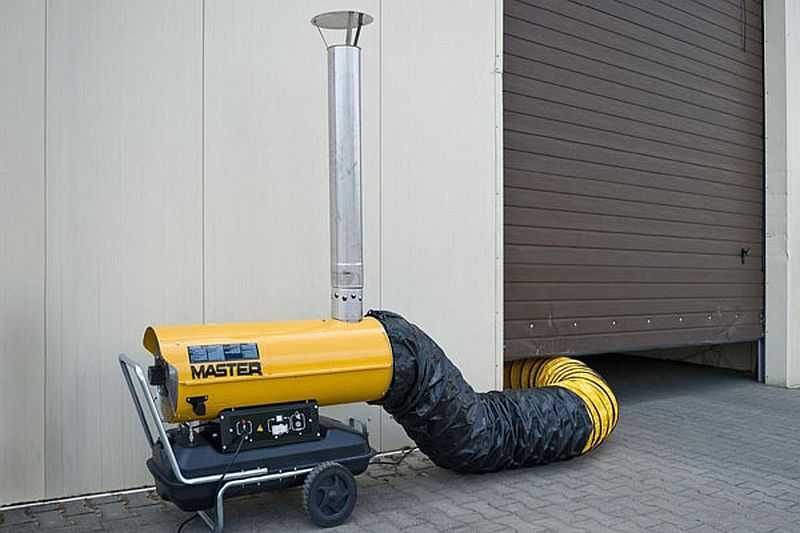

One of the options for safe use
If diesel heat guns are still more suitable for you, you should know that they are of two types - direct and indirect heating. With direct heating, gaseous combustion products (including carbon monoxide) remain in the room; with indirect heating, they are discharged through the branch pipe. You understand why such a situation is unpleasant and dangerous.
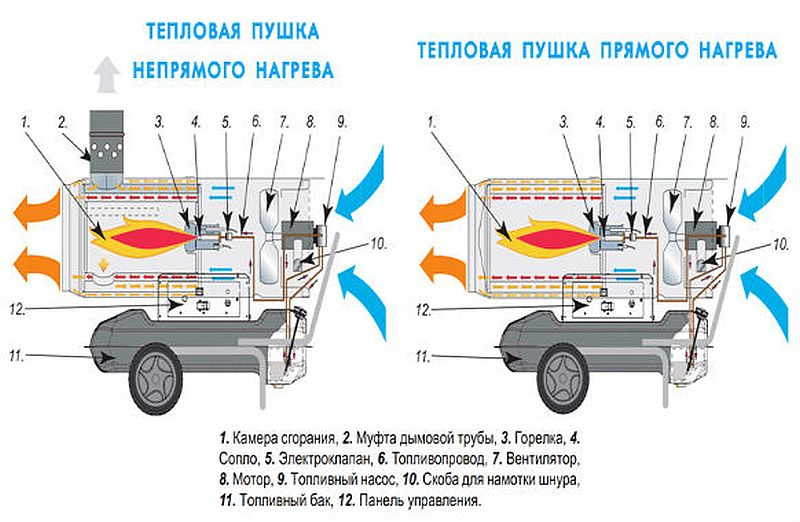

What is the difference between diesel heat guns of indirect and direct heating
The second option is that indirect heat guns for heating premises are more acceptable. But to remove the gases, you will have to pull the chimney from the cannon, which is not always convenient and costly. But you don't have to worry about smells and carbon monoxide. There is almost no smell.
Indirect diesel heat guns can even be used to heat a home. For this case, it is better to take universal models. They can still run on engine oil (including used oil). In addition, the usually universal model allows you to change the fan speed, burner power, and is equipped with sensors that monitor safety.
Directly heated diesel fuel heaters can be found with power from 10 to 220 kW, indirect - up to 85 kW. The operating time is limited only by the volume of the fuel tank, but can usually work up to 8-10 hours. If there is a thermostat, then one tank can be enough for a day or so. If we talk about efficiency, then they are not the highest efficiency (efficiency). Compared to multi-fuel ones, diesel ones consume 10-15% more fuel per unit of heat (even if the same diesel fuel is used).
Multi-fuel
Universal units that can work with any liquid fuel: diesel fuel, kerosene, engine oil. These aggregates and working off are "digested". So they are profitable at service stations or at other enterprises where this fuel is sufficient. Their efficiency is about 100%, they can work without interruption for 10-12 hours. Power of multi-fuel heat guns of direct heating - up to 280 kW, indirect - up to 80 kW.
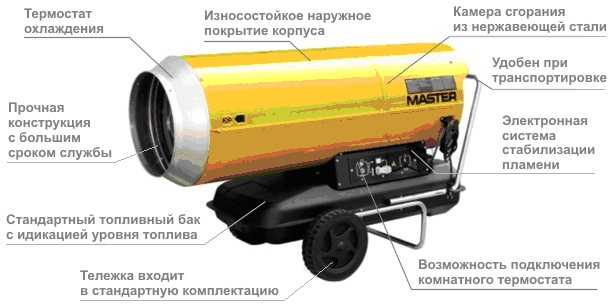

Multi-fuel options are more versatile
The disadvantage of such equipment is the price - much higher than diesel ones with similar parameters. Just remember that multi-fuel or diesel heat guns of direct heating cannot be used to heat rooms where people are for a long time.
Diesel heat guns: principle of operation and selection rules
Diesel heat guns are safe, mobile devices that consist of a fuel tank, pump or compressor, combustion chamber, burner and fan. Diesel models with power ratings from 2.5 to 100 kW can be found on the modern market. Separately, there are powerful industrial heat guns with a capacity of 140-160 kW.
According to the principle of operation, Diesel cannons are divided into:
- Direct heating devices;
- Units with indirect heating.
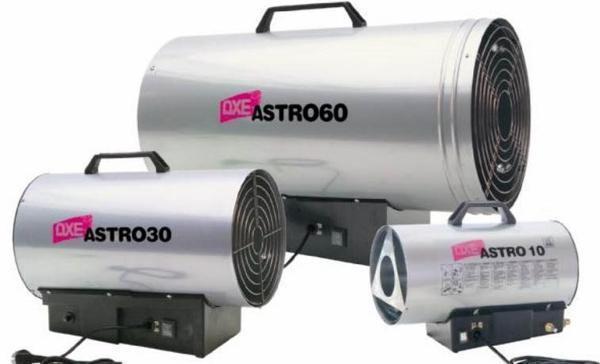

Diesel heating units with direct heating are characterized by high efficiency (about 90%). The disadvantage of such devices is that heated air is generated from the cannon together with combustion products. Therefore, they are not recommended for indoor use. But such devices are ideal for rapid heating of large production and storage facilities, for drying concrete screed at construction sites.
For residential installations, select indirect diesel heaters.
The principle of operation of such a heater is that the heated air is transported without harmful substances. The cost of such heaters is higher than that of devices with direct heating. But they can be installed in absolutely any room, regardless of size, type of ventilation, and permeability.
And for greenhouses, gas heaters will be the best heating method. They will help you get a rich harvest at no extra cost. Read about this in the article:
How to choose the right
Before deciding on the correct choice of a heating unit, first of all, you need to know by what criteria to select this type of equipment.
Watch a video in which an experienced user clearly demonstrates the features of an indirect diesel heat gun for heating a garage:
As a rule, heat guns of various configurations are used to dry out buildings under construction, heat production facilities of a wide profile, because these are powerful high-performance machines. But recently, many manufacturers have set up the production of small-sized devices up to 3-5 kW, so that numerous motorists have a heat gun for a garage on the farm, with which you can quickly heat a small room.
Equipment of this class is an efficient device for heating any room using directed hot air. The efficiency of any heat gun reaches almost 100%.
On sale there are such varieties of these products:
- Electric - they work for heating only when there is a household power supply.
- Diesel - the principle of operation is based on fuel combustion in a combustion chamber with subsequent heating of the air flow.
- Gas - the principle is similar to the second option, but they run on blue fuel, they are much more economical, because gas is cheaper.
Each species has its own specific features, advantages and minor disadvantages.
Electrical
Electric fan heaters have the following advantages:
- small dimensions allow you to install the product in almost any room;
- full automatic control;
- silent work;
- fairly high level of fire safety.
The disadvantages include the high cost of electrical energy. In addition, before installing the heat gun, the wiring must be checked so that it can withstand the voltage from the use of such equipment. Devices must have overheating protection
and automation to maintain an optimal constant temperature.
Diesel
These products have two types of heating: direct and indirect
... In the first option, the room is heated by an air flow, in which combustion products are present, therefore, it is necessary to install forced ventilation. In the case of indirect heating, the heat gun has a design that allows the combustion products to be removed from the combustion chamber through a special branch pipe, which is sufficient to connect it to a chimney pipe or a corrugated hose.
When a heat gun is selected for the garage, then all the options must be thought over and calculated - take into account the volume of the room, how to draw out the combustion products. Without a doubt, a device with indirect heating is much better than an analogue with a direct heating method, when there is a danger of smoke forming the entire room.
Experts attribute the following indicators to the merits:
- economical fuel consumption;
- heat guns of this class operate on one tank filling up to 14 hours;
- efficient heating of a garage of any size, even two floors.
The disadvantages are diesel fuel cost
, and from the smell of burnt diesel fuel, an unpleasant amber remains, which is not drawn out by any ventilation system.
Gas
Such guns have a number of advantages over their diesel counterparts:
- heat the room much faster;
- heating of this type is many times more economical due to the lower consumption and cost of gas;
- there is a sensor that reads the concentration of carbon dioxide;
- automation that controls equipment overheating;
- propane or butane burns out completely - no need to install special exhaust systems, ordinary ventilation, which is in every garage, is enough.
There is one, but rather significant drawback: for the operation of the unit, liquefied gas cylinder
which is quite difficult to get hold of.
Advice! If there is no good ventilation in the garage, then all the options will not suit you, the heating of the room will not be carried out in full due to the frequent ventilation by opening the gate.
Gas cannon in the garage: features of choice
A household heat gun in a garage is a gift for many motorists, because, often, there is no opportunity to organize heating in buildings of this type. And working in the garage in the winter can be extremely uncomfortable. Gas cannons are especially popular with garage owners: they are affordable, quiet and do not emit carcinogenic substances.
When choosing a gas cannon for a garage, you should determine the optimal power of the device based on 1 kW of thermal power per 10 square meters of room area with ceilings no higher than 3 m.
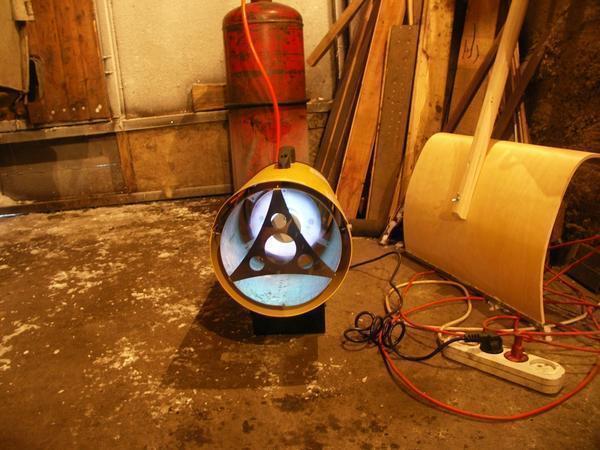

So, the best option for an average garage of 25 square meters would be a heating installation with a capacity of 3-5 kW. An insufficiently powerful gun will not cope with its task, and an overabundance of power will affect the amount of fuel and electricity required to operate the device.
At the same time, experts recommend insulating the garage or, at least, eliminating cracks and holes through which warm air can be removed.
Firstly, it will be easier to calculate the required power of the gun. Secondly, you do not have to overpay for heating the "street". Insulating the building will also be useful if you decide to store the heater directly in the garage: the optimal temperature for storing equipment is +5 degrees.
Extra options
We figured out which electric heat gun is better to choose in terms of power and depending on the type of room. But that's not all you need to know about this issue. It is very important to pay attention to the following points when choosing a heater:
The gun consists of heating elements, a fan, a thermostat and, of course, a body. The powerful fan creates an air flow that passes through the heating elements and comes out warm. The garage can be used not only for storing a car and other things, it can also be used for car repairs. For year-round work in the garage, it is not bad to have heating, some install electric heaters, but it happens that there is not enough power.
How to choose a heat gun: recommendations
When choosing a heater, one should take into account not only the power of the gun and the size of the room, but also the quality of ventilation in the room. There are many nuances on which the comfort and safety of using a thermal device, its durability and efficiency depend.
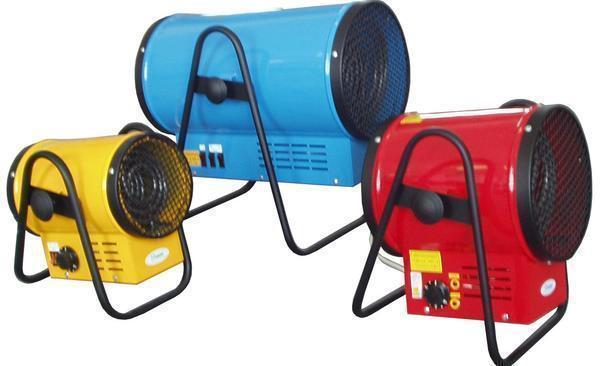

So, when choosing a heating installation, it is necessary:
- Decide for what purpose you need the device. You can buy a gas or electric cannon to heat living rooms. But, it should be borne in mind that for the second one you need a permanent connection to the electricity network with a voltage of 220-380 V.
- Make sure that there are autonomous safety systems in the structure. So, the heating gun, at a minimum, must have sensors that will autonomously interrupt the operation of the device in the event of a fire hazard (for example, overheating).
- Pay attention to the presence of additional functions, components. So, an electric heat gun should be equipped with a special protective mesh; household appliances - have a thermostat that allows you to set the desired temperature, and portable devices come complete with wheels.
- Pay attention to the noise level that the device emits during operation. The optimum noise level is considered to be within 40 dB.
If you choose a heat gun in a store, then it will not be superfluous to ask the staff to conduct a test drive of the model in order to check its performance.
But the cannon for stretch ceilings is allowed to be used only by professionals. What are the types of device features, you can find out on the next page:
Specifications
The first thing you should start from is what parameters are suitable for the normal operation of an electric heat gun. The selection should be based on power and suitable voltage.
As for the first characteristic, there are two calculation options. A simpler method of determination is that for heating 10 sq.m. premises need at least 1 kW of power. In total, if you have a room of 4 * 6 meters (for example, a garage), simple calculations will show that you need to choose the power of an electric heat gun, not less than 3 kW. We defined it as follows: 4 * 6 will be 24 square meters, taking into account the recommendations that the power reserve should be at least 20%, we have: 2.4 * 1.2 = 2.88 kilowatts.The closest value of 3 kW, which must be selected for heating the garage.
The second calculation method is more accurate, and we recommend using it when choosing an electric heat gun for the house. In this case, the formula does not take into account the area of the room, but its volume and the coefficient of thermal conductivity of the walls. As a result, the formula looks like:
P = (V * dT * Kt) / 860,
- V is the volume of the room, calculated as the area multiplied by the ceiling height, m3;
- dT is the difference between the ambient and indoor temperature;
- Kt - coefficient of thermal conductivity. For walls with high-quality thermal insulation from 0.6 to 1. Average thermal insulation or brick laying in two rows - from 1 to 2. Single-row brick laying, poor thermal insulation - from 2 to 3. Dilapidated hangars made of profiled sheet or boards - a coefficient from 3 to 4 $
- 860 - the number of kcal per 1 kW.
Power marking - 9 kW
So that you understand the whole essence of the calculation, again, consider it with an example. You have decided to choose an electric heat gun for the garage, or rather, to warm up the car. The volume of the room is all the same 4 * 6 meters * 3 (ceiling height). The temperature inside the building should be +15 o C, outside it is now -20 o C. Total, the difference is 35 degrees. The garage is well insulated, so we take the coefficient 1. As a result, the calculation formula will look like: 72 * 35 * 1 = 2520 kcal / hour. To convert the value to kW, you must divide it by 860. The total is 2520/860 = 2.93 kW. Taking into account the margin, it is necessary to select a heat gun of at least 3.5 kW, which will be quite enough.
Immediately, we draw your attention to the fact that there is a conditional classification of devices by power. It is believed that up to 5 kW these are fan heaters, and already more than guns. with reviews of the most popular models, we reviewed in the corresponding article!
The second, no less important technical characteristic is the operating voltage. There are electric heaters with a power of over 20 kW, for the operation of which, of course, a three-phase network of 380 V is needed.You should also take this point into account if you decide to choose an electric heat gun for heating a garage or giving an electric heat gun, to a new, more powerful one. Devices with a power of up to 7 kW can be connected to a single-phase 220 V network, if the wire cross-section allows. It is best to do before connecting to ensure that your wiring can handle these current loads.
Well, the last thing you need to pay attention to when choosing a heat gun is the operating time. As you understand, when a room is heated with a gun, it must work without interruption for a long time. That is why device manufacturers indicate on the case the value "24/1" or "24/2", which respectively means round-the-clock work with a break of 1-2 hours.
In addition, in order to choose the right electric heat gun according to its characteristics, pay attention to the noise level of its operation and the operating temperature range. Modern devices must operate at temperatures no less than +5 o C to +40 o C.
Video review of heaters for home and construction
Which heat gun to choose: rating of the best devices
When choosing heat guns, buyer's experience should be taken into account. Based on user reviews, an overview of the highest quality and most efficient heating devices can be made.
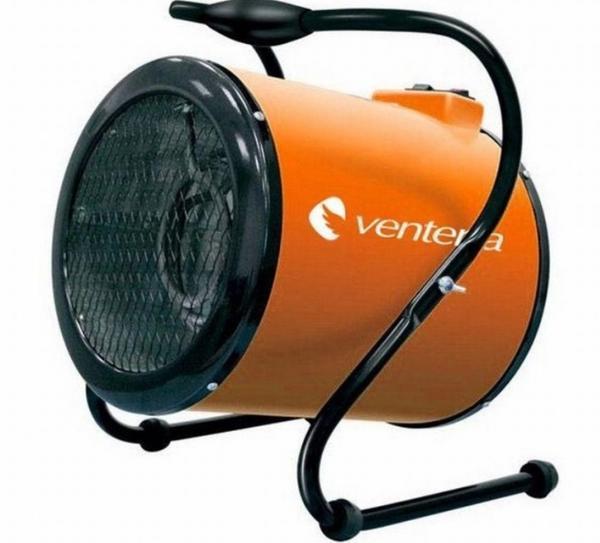

So, have proven themselves well:
- Electric heater Interskol TPE-3;
- BLP 17M gas cannon from the American company Master;
- Oil fuel heater BV 77E from Master.
Models from manufacturers Sial and Kroll are distinguished by high quality products. Both companies make mobile heat guns with built-in thermostats, a reliable overheating protection system and a lot of additional options.
Additional functions
Of the additional functions in gas heat guns, there are:
- System automatic arson... It works either from the mains or as a mechanical piezoelectric element. In their absence, the device is started manually (bring a match or any other burning element to the burner nozzle).
- Rotation speed control fan. This functionality allows you to adjust the air flow rate. For small rooms - less, for large - more.
- Gas supply adjustment... It is used to turn on the "turbo mode" when the heating element heats up in literally 10 - 20 seconds. Allows you to start heating the room instantly.
- Availability additional sensors... These include a gas leakage sensor, a gas pressure reduction sensor, a thermostat (responsive to the ambient temperature), a position indicator (in case of accidental overturning of the gun, it blocks the gas supply, while the device is turned off).
- Thermocouple... Allows the fan to automatically adjust the rotation speed depending on the temperature in the combustion chamber or heating element.
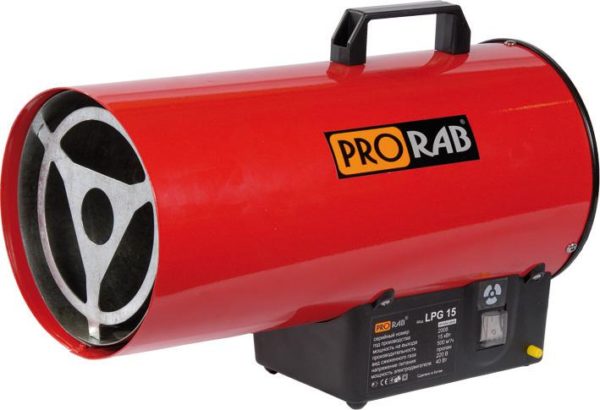

Also, manufacturers began to produce automatic gas guns that work on the principle of conventional electric heaters with a thermostat. That is, they turn on and off automatically, maintaining the room temperature at a given level. However, the response threshold of such devices is high, so you should not count on careful observance of the temperature up to 0.5 degrees.
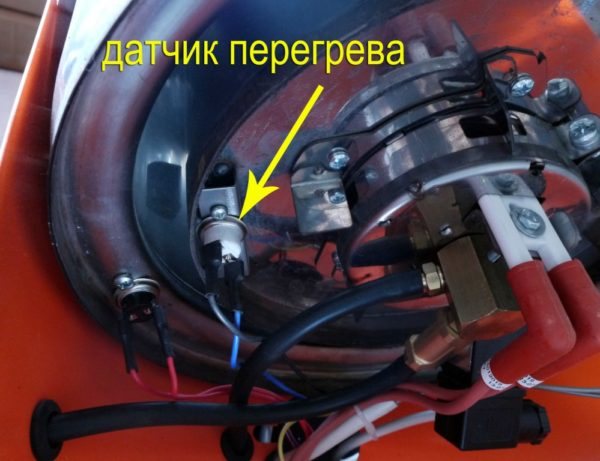

Video - Gas cannon, garage heating (is it worth taking)
Find out how to choose a gas floor heating boiler for a private house in a special article on our portal.
What is a diesel heat gun (video)
Heat guns are mobile, affordable and economical devices that allow you to quickly warm up the room, speed up the installation of floors and ceilings. Today, the most popular heat guns are electric heaters, devices that run on gas, diesel fuel. Which gun is better to choose depends on the size and purpose of the room, the quality of ventilation in the room, and the availability of a connection to the central power grid. And the above tips and ratings can help with the choice.
- Author: admin
Rate the article:
- 5
- 4
- 3
- 2
- 1
(0 votes, average: 0 out of 5)
Share with your friends!
How to make the right choice?
Before choosing equipment of this type for heating your garage or any other structure of identical functionality, you need to know by what criteria fan heaters are selected.
To choose a cannon for your garage - gas, electric or diesel, you need to take into account the following factors:
- the volume of the room that needs heating;
- prolonged stay in the room;
- the presence of combustible materials in the heated structure.
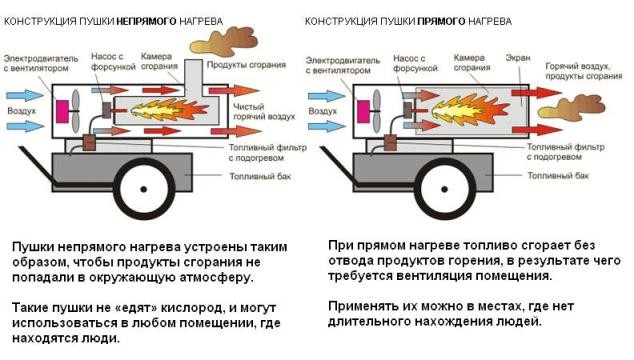

Direct and indirect heating guns.
In addition, when choosing such a heating tool, it is important to pay attention to the technical characteristics of the equipment, including:
- angle of coverage of warming up;
- unit power;
- fuel / electricity consumption;
- Operating temperature range;
- fuel tank volume;
- weight of equipment;
- dimensions.
Additional functions also play an important role:
- automatic ignition;
- protection and security system;
- the presence of a thermostat;
- type of system for artificial maintenance of a given temperature regime;
- the presence of a control panel.
The required power of the fan heater is calculated from the ratio of 10 rooms per 1 kW of equipment power. For example, if the area of the room is 15, then it is advisable to purchase a 1.5 kW heat gun. And taking into account the factors of strong frosts, it is better to take a heat gun with a capacity of about 4 kW.

